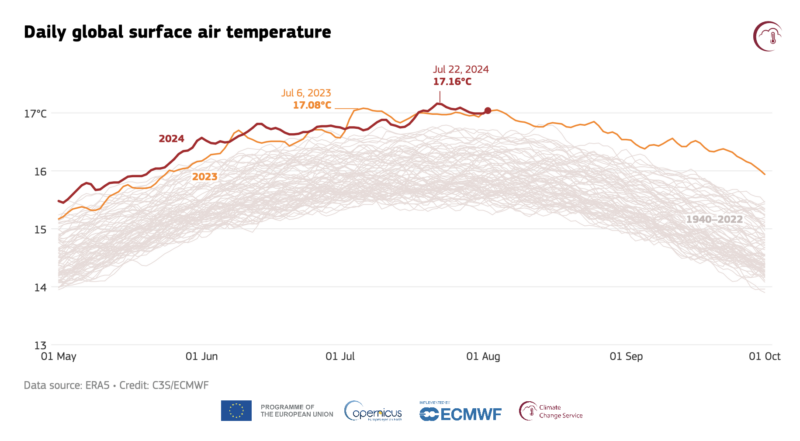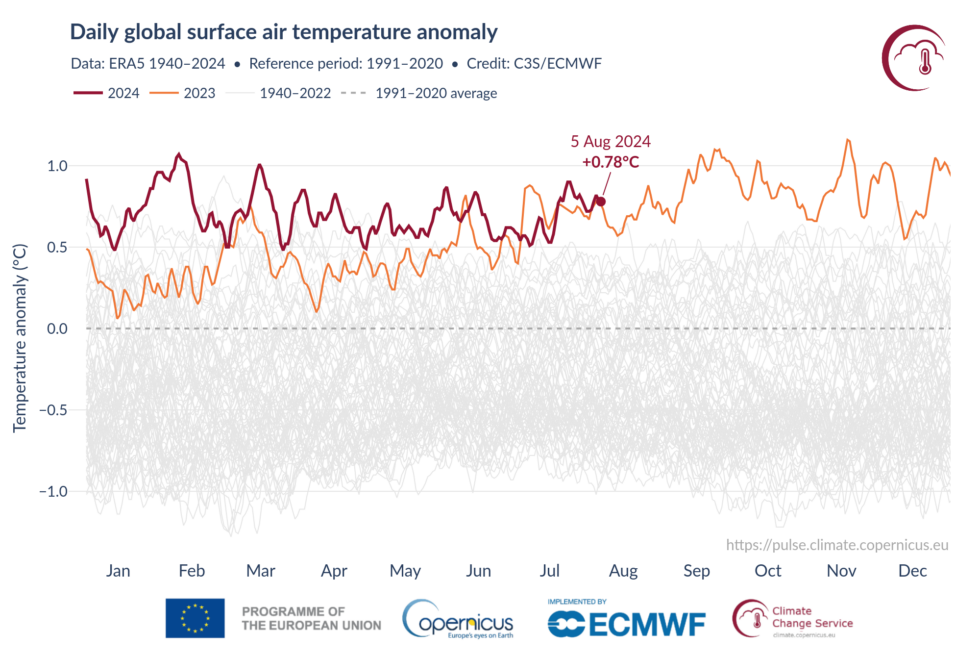
The past several years have been absolute scorchers, with 2023 being the warmest year ever recorded. And things did not slow down in 2024. As a result, we entered a stretch where every month set a new record as the warmest iteration of that month that we’ve ever recorded. Last month, that pattern stretched out for a full 12 months, as June of 2024 once again became the warmest June ever recorded. But, despite some exceptional temperatures in July, it fell just short of last July’s monthly temperature record, bringing the streak to a close.
Europe’s Copernicus system was first to announce that July of 2024 was ever so slightly cooler than July of 2023, missing out on setting a new record by just 0.04° C. So far, none of the other major climate trackers, such as Berkeley Earth or NASA GISS, have come out with data for July. These each have slightly different approaches to tracking temperatures, and, with a margin that small, it’s possible we’ll see one of them register last month as warmer or statistically indistinguishable.
How exceptional are the temperatures of the last few years? The EU averaged every July from 1991 to 2020—a period well after climate change had warmed the planet significantly—and July of 2024 was still 0.68° C above that average.
While it didn’t set a record, both the EU’s Copernicus climate service and NASA’s GISS found that it contained the warmest day ever recorded. In the EU’s case, they were the two hottest days recorded, as the temperatures on the 21st and 22nd were statistically indistinguishable, with only 0.01° C separating them. Late July and early August tend to be the warmest times of the year for surface air temperatures, so we’re likely past the point where any daily records will be set in 2024.
That’s all in terms of absolute temperatures. If you compare each day of the year only to instances of that day in the past, there have been far more anomalous days in the temperature record.

That image also shows how exceptional the past year’s temperatures have been and makes it clear that 2024 is only falling out of record territory because the second half of 2023 was so exceptionally warm. It’s unlikely that 2024 will be quite as extreme, as the El Niño event that helped drive warming appears to have faded after peaking in December of 2023. NOAA’s latest forecast expects that the Pacific will remain in neutral for another month or two before starting to shift into cooler La Niña conditions before the year is out. (This is based on the August 8 ENSO forecast obtained here.)
In terms of anomalies, July also represents the first time in a year that a month had been less than 1.5° C above preindustrial temperatures (with preindustrial defined as the average over 1850–1900). Capping our modern temperatures at 1.5° C above preindustrial levels is recognized as a target that, while difficult to achieve, would help avoid some of the worst impacts we’ll see at 2° C of warming, and a number of countries have committed to that goal.
Listing image by Dmitriy83

